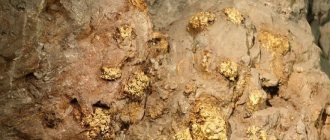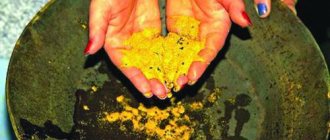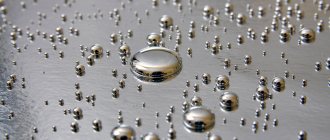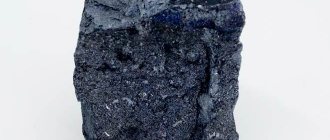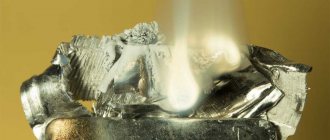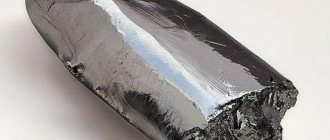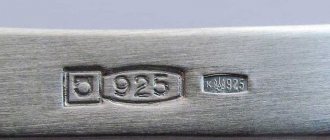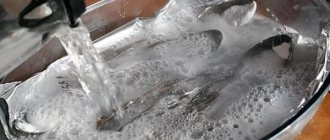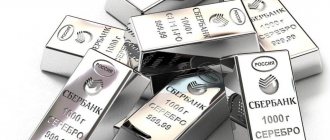Silver
(
Ag
from Latin Argentum) is an element of group 11 (according to the outdated classification - a secondary subgroup of the first group), the fifth period of D. I. Mendeleev’s periodic table of chemical elements, with atomic number 47.
Simple substance silver
- malleable, ductile noble metal of silver-white color. The crystal lattice is face-centered cubic. Melting point - 962 °C, density - 10.5 g/cm³.
| Name, symbol, number | Silver / Argentum (Ag), 47 |
| Atomic mass (molar mass) | 107.8682(2)[2] a. e.m. (g/mol) |
| Electronic configuration | [Kr] 4d10 5s1 |
| Atomic radius | 144 pm |
| Covalent radius | 134 pm |
| Ion radius | (+2e) 89 (+1e) 126 pm |
| Electronegativity | 1.93 (Pauling scale) |
| Electrode potential | +0,799 |
| Oxidation states | 2, 1 |
| Ionization energy | 1st: 730.5 kJ/mol (eV) 2nd: 2070 kJ/mol (eV) 3rd: 3361 kJ/mol (eV) |
| Density (at normal conditions) | 10.5 g/cm³ |
| Melting temperature | 1235.1 K; 962 °C |
| Boiling temperature | 2485 K; 2162°C |
| Ud. heat of fusion | 11.95 kJ/mol |
| Ud. heat of vaporization | 254.1 kJ/mol |
| Molar heat capacity | 25.36[3] J/(K mol) |
| Molar volume | 10.3 cm³/mol |
| Lattice structure | cubic face-centered |
| Lattice parameters | 4.086 Å |
| Debye temperature | 225 K |
| Thermal conductivity | (300 K) 429 W/(mK) |
| CAS number | 7440-22-4 |
Story
Silver has been known to mankind since ancient times. This is due to the fact that at one time silver, like gold, was often found in its native form - it did not have to be smelted from ores. This predetermined the rather significant role of silver in the cultural traditions of various peoples. One of the oldest centers for the extraction and processing of silver was prehistoric Sardinia, where it was known since the early Eneolithic.
In Assyria and Babylon, silver was considered a sacred metal and was a symbol of the Moon. In the Middle Ages, silver and its compounds were very popular among alchemists. Since the middle of the 13th century, silver has become a traditional material for making tableware. In addition, silver is still used to this day for minting commemorative coins (the withdrawal of the last silver coins from circulation in the 1960s and 1970s approximately coincided with the crisis of the Bretton Woods monetary system).
origin of name
Slavic names of metal - Russian. silver, Polish srebro, Bulgarian silver, ancient glory silver - goes back to the Proto-Slavic *sеrebro
, which has correspondences in the Baltic (Lit. sidabras, Old Prussian
sirablan
) and Germanic (Gothic silubr, German Silber, English silver) languages.
Further etymology outside the German-Balto-Slavic circle of languages is unclear, suggesting either a derivation from the same base as Anatolian subau-ro
“brilliant”, or an early borrowing from the languages of the Middle East: cf. Akkadian sarpu "refined silver", from Akkad. sarapu “to purify, to melt,” or from the pre-Indo-European languages of ancient Europe: cf. Basque. zilar.
The Greek name for silver is ἄργυρος, árgyros
comes from the Indo-European root
*H₂erǵó-, *H₂erǵí-
, meaning “white, shining.”
argentum,
comes from the same root .
origin of name
If we talk about the name in more detail, then everything is not as simple as mentioned above. Not only in the Proto-Slavic dialect there was a word similar to the modern “silver”. The discovery of specialists showed that similar words exist in the Anatolian group of languages, in languages common in the Middle East, as well as in pre-Indo-European languages of European countries.
It is very difficult, if not impossible, to establish the degree to which a word belongs to a particular culture. There is also a Greek word for silver, árgyros, from which comes the Latin argentum, adopted by the international community as the main name in the international system and periodic table.
Being in nature
The average silver content in the earth's crust (according to Vinogradov) is 70 mg/t. Its maximum concentrations are found in clayey shales, where they reach 1 g/t. Silver is characterized by a relatively low energy index of ions, which causes an insignificant manifestation of isomorphism of this element and its relatively difficult inclusion in the lattice of other minerals. Only a constant isomorphism of silver and lead ions is observed. Silver ions are included in the lattice of native gold, the amount of which sometimes reaches almost 50% by weight in electrum. In small quantities, the silver ion is included in the lattice of copper sulfides and sulfosalts, as well as in the composition of tellurides developed in some polymetallic and especially in gold-sulfide and gold-quartz deposits.
A certain part of noble and non-ferrous metals occurs in nature in native form. The facts of finding not just large, but huge nuggets of silver are known and documented. For example, in 1477, a silver nugget weighing 20 tons was discovered at the St. George mine (Schneeberg deposit in the Ore Mountains, 40-45 km from the city of Freiberg). A block of silver measuring 1 × 1 × 2.2 m was dragged out of the mine workings, had a festive dinner on it, and then split it and weighed it. In Denmark, in the Copenhagen Museum, there is a nugget weighing 254 kg, discovered in 1666 at the Norwegian Kongsberg mine. Large nuggets were also discovered on other continents. Currently, one of the native silver plates mined at the Cobalt mine in Canada, weighing 612 kg, is stored in the Canadian Parliament building. Another plate, found at the same deposit and called “silver pavement” for its size, was about 30 m long and contained 20 tons of silver. However, with all the impressiveness of the finds ever discovered, it should be noted that silver is chemically more active than gold, and for this reason is less common in nature in its native form. For the same reason, the solubility of silver is higher and its concentration in seawater is an order of magnitude greater than that of gold (about 0.04 μg/l and 0.004 μg/l, respectively).
Silver ore, Primorye
More than 50 natural silver minerals are known, of which only 15–20 are of industrial importance, including:
- native silver;
- electrum (gold-silver);
- kustelite (silver-gold);
- argentite (silver-sulfur);
- proustite (silver-arsenic-sulfur);
- bromargerite (silver-bromine);
- kerargyrite (silver-chlorine);
- pyrargyrite (silver-antimony-sulfur);
- stephanite (silver-antimony-sulfur);
- polybasite (silver-copper-antimony-sulfur);
- freibergite (copper-sulfur-silver);
- argentoyarosite (silver-iron-sulfur);
- dyscrazite (silver-antimony);
- aguilarite (silver-selenium-sulfur)
Like other noble metals, silver has two types of manifestations:
- actual silver deposits, where it accounts for more than 50% of the cost of all useful components;
- complex silver-containing deposits (in which silver is included in the ores of non-ferrous, alloying and precious metals as an associated component).
Silver deposits themselves play a fairly significant role in global silver production, but it should be noted that the main proven reserves of silver (75%) come from complex deposits.
The silver content in ores of non-ferrous metals is 10-100 g/t, in gold-silver ores 200-1000 g/t, and in ores of silver deposits 900-2000 g/t, sometimes tens of kilograms per ton.
Silver is also found in caustobolites: peat, oil, coal, bituminous shale.
Place of Birth
Silver production by country (2011)
Significant silver deposits are located in the territories of the following countries:
- Armenia,
- Germany,
- Spain,
- Peru,
- Chile,
- Mexico,
- China,
- Canada,
- USA,
- Australia,
- Poland,
- Russia,
- Kazakhstan,
- Romania,
- Sweden,
- Czech Republic,
- Slovakia,
- Austria,
- Hungary,
- Norway.
There are also silver deposits in Cyprus and Sardinia.
Similar metals
Silver is a non-ferrous metal that is sometimes difficult to distinguish from similar ones in appearance. This is not easy to do, but it is quite possible.
The metal that looks like silver can be white gold, cupronickel, or aluminum. How can you tell them apart? Only professionals familiar with the specifics of these metals can determine whether a product is made of silver or white gold. Doing this yourself at home is not recommended.
Externally, these two metals are very similar to each other. The fact is that the white gold alloy contains a large percentage of silver. Only a jeweler can distinguish products made from these materials, who can calculate the original by density.
Silver is a non-ferrous metal that is often confused with cupronickel. The latter is an alloy of nickel, lead and copper. Cupronickel often is a production component of silver of various technical grades. How to distinguish “metal like silver”? First of all, you need to carefully consider the existing product. There will be no hallmark on cupronickel. On such products only the “MNC” mark is placed, which indicates the composition of the alloy (copper, nickel and lead). Silver differs from the alloy in density and weight. However, only a specialist can determine these characteristics. At home, you can drip iodine solution onto the product. After this, a stain will remain on silver, but not on cupronickel.
Often they try to pass off aluminum as a noble metal. However, the latter has significant differences from silver in density, luster, hardness and color. They try to sell counterfeit products only in doorways and various shops. This type of jewelry begins to oxidize after wearing for a short time. You can distinguish silver from aluminum using a magnet. Noble metal will not be attracted to it. In addition, any physical or chemical impact on aluminum causes a change in its color, appearance and dimensional deformation.
Physical properties
Silver coin
Pure silver is a fairly heavy (lighter than lead, but heavier than copper, density - 10.5 g/cm³), unusually ductile silver-white metal (light reflection coefficient is close to 100%). Thin silver foil appears violet in transmitted light. Over time, the metal tarnishes, reacting with traces of hydrogen sulfide in the air and forming a coating of sulfide, whose thin film then gives the metal its characteristic pinkish color. It has the highest thermal conductivity among metals. At room temperature it has the highest electrical conductivity among all known metals (electrical resistivity 1.59⋅10−8 Ohm m at a temperature of 20 °C). A relatively refractory metal, melting point 962 °C.
Silver crystal lattice:
| 500 | Crystal cell | |
| 511 | Crystal grid #1 | |
| 512 | Lattice structure | Cubic face centered |
| 513 | Lattice parameters | a = 4.086 Å |
| 514 | c/a ratio | |
| 515 | Debye temperature | 225 K |
| 516 | Name of space symmetry group | Fm_3m |
| 517 | Symmetry space group number | 225 |
Chemical properties
Silver, being a noble metal, has a relatively low reactivity; it does not dissolve in hydrochloric and dilute sulfuric acids. However, in an oxidizing environment (in nitric acid, hot concentrated sulfuric acid, and also in hydrochloric acid in the presence of free oxygen), silver dissolves:
Ag + 2HNO3(conc) = AgNO3 + NO2↑ + H2O
It also dissolves in ferric chloride, which is used for etching:
Ag + FeCl3 = AgCl + FeCl2
Silver also dissolves easily in mercury, forming an amalgam (a liquid alloy of mercury and silver).
Silver is not oxidized by oxygen even at high temperatures, but in the form of thin films it can be oxidized by oxygen plasma or ozone when irradiated with ultraviolet light. In humid air in the presence of even the slightest traces of divalent sulfur (hydrogen sulfide, thiosulfates, rubber), a deposit of poorly soluble silver sulfide is formed, causing the darkening of silver items:
4Ag + 2H2S + O2 = 2Ag2S + 2H2O
In the absence of oxygen:
2Ag + H2S = Ag2S + H2↑
Free halogens easily oxidize silver to halides:
2Ag + I2 = 2AgI
However, in the light this reaction is reversed, and the silver halides (except fluoride) gradually decompose. The principle of black and white photography is based on this phenomenon.
When heated with sulfur, silver gives sulfide:
2Ag + S = Ag2S
The most stable oxidation state of silver in compounds is +1. In the presence of ammonia, silver (I) compounds give the complex [Ag(NH3)2]+, which is easily soluble in water. Silver also forms complexes with cyanides and thiosulfates. Complexation is used to dissolve poorly soluble silver compounds and to extract silver from ores. Silver exhibits higher oxidation states (+2, +3) only in combination with oxygen (AgO, Ag2O3) and fluorine (AgF2, AgF3); such compounds are much less stable than silver (I) compounds.
Silver(I) salts, with rare exceptions (nitrate, perchlorate, fluoride), are insoluble in water, which is often used to determine halogen ions (chlorine, bromine, iodine) in aqueous solution.
Advantages and disadvantages
Advantages:
- Silver jewelry goes with any outfit. The same cannot be said about gold. Gold items can ruin a person's appearance. It often overshadows the appearance of clothing, attracting increased attention.
- It is customary to wear gold jewelry for large celebrations and ceremonies. Silver is suitable for any holiday, business meeting, interview.
- Silver jewelry is suitable for both men and women. There are no predominant factors for gender differences.
- Durability, strength, wear resistance.
This metal has no serious drawbacks, except that it darkens over time.
Application
Silver bars
- Since it has the highest electrical conductivity, thermal conductivity and resistance to oxidation by oxygen under normal conditions, it is used for contacts of electrical products (for example, relay contacts, lamellas), as well as multilayer ceramic capacitors.
- The solders contain: copper-silver solders PSr-72, PSr-45 and others, used for soldering a variety of critical connections, including dissimilar metals; solders with a high silver content are used in jewelry, and with a medium content - in a variety of equipment, from high-current switches to liquid rocket engines, sometimes also as an additive to lead in the amount of 3% (PSr-3), it replaces tin solder.
- Composed of alloys: for the manufacture of cathodes of galvanic cells.
- It is used as a precious metal in jewelry (usually in an alloy with copper, sometimes with nickel and other metals).
- It is used in the minting of coins (circulating coins until the early 1970s, now only commemorative coins), as well as awards - orders and medals.
- Silver halides and silver nitrate are used in photography because they have high photosensitivity.
- Silver iodide is used to change the weather (“dispersal of clouds”).
- Due to the highest electrical conductivity and oxidation resistance, it is used: in electrical engineering and electronics as a coating for critical contacts and conductors in high-frequency circuits;
- in microwave technology as a coating for the inner surface of waveguides.
The areas of application of silver are constantly expanding, and its applications include not only alloys, but also chemical compounds. A certain amount of silver is constantly consumed for the production of silver-zinc and silver-cadmium batteries, which have very high energy density and mass energy intensity and are capable of delivering very high currents to the load with low internal resistance.
Silver is used as an additive (0.1-0.4%) to lead for casting current collectors of positive plates of special lead-acid batteries that have a very long service life (up to 10-12 years) and low internal resistance.
Silver chloride is used in silver-zinc chloride batteries and in the coatings of some radar surfaces. In addition, silver chloride, which is transparent in the infrared region of the spectrum, is used in infrared optics.
Silver fluoride single crystals are used to generate laser radiation with a wavelength of 0.193 microns (ultraviolet radiation).
Silver is used as a catalyst in gas mask filters.
Silver acetylide (carbide) is occasionally used as a powerful initiating explosive (detonators).
Silver phosphate is used to melt special glass used for radiation dosimetry. The approximate composition of such glass is: aluminum phosphate - 42%, barium phosphate - 25%, potassium phosphate - 25%, silver phosphate - 8%.
Silver permanganate, crystalline dark purple powder, soluble in water; used in gas masks. In some special cases, silver is also used in dry galvanic cells of the following systems: chlorine-silver cell, bromine-silver cell, iodine-silver cell.
Silver is registered as a food additive E174.
In medicine
Main article: Colloidal silver
Until the mid-20th century, silver nitrate was used as a topical antiseptic under the name lapis. In light it decomposes into free silver, nitrogen dioxide and molecular oxygen. However, many significantly more effective antiseptics are now used in all areas.
Since 1990, alternative medicine has seen a resurgence in the use of colloidal silver as a treatment for numerous ailments. Laboratory studies have yielded varying results: some studies have shown that silver has very little antimicrobial effect, while others have shown that a 5-30 ppm solution is effective against staphylococcus and E. coli. This contradiction is associated with the size of colloidal silver nanoparticles - the smaller their size, the more pronounced the antimicrobial effect. It should be noted that similar properties of nanoparticles are characteristic of most transition metals and are associated with the destruction of the bacterial cell membrane during the sorption of nanoparticles. This, however, only appears in very pure solutions.
Silver is a heavy metal, the content of which in drinking water is regulated by SanPiN 2.1.4.1074-01 “Drinking water” - silver is assigned hazard class 2, “highly hazardous substance”. The State Sanitary and Epidemiological Supervision Authority has officially approved hygienic standards for the content of harmful substances in drinking water; in these standards, the silver content in drinking water is limited to a concentration of 0.05 mg/l.
In the USA and Australia, preparations based on colloidal silver are not recognized as medicines and are offered in grocery stores. They can also be found in abundance in online stores around the world as dietary supplements (dietary supplements), a simpler name is food additives. US and Australian law prohibited marketers from attributing medical benefits to colloidal silver. But some sites, including on their territory, still indicate the beneficial effects of the drug in the prevention of colds and flu, as well as therapeutic effects for more serious diseases such as diabetes, cancer, chronic fatigue syndrome, HIV/AIDS, tuberculosis and other diseases. There are no medical studies showing that colloidal silver is effective for any of these reported symptoms.
Before the era of evidence-based medicine, solutions of silver salts were widely used as antiseptics and astringents. The action of such drugs as protargol, collargol, etc., which are colloidal forms of silver, is based on this property of silver. Currently, silver preparations are used less and less due to low efficiency.
Isotopes
There are two naturally occurring isotopes of silver: silver-107 and silver-109. Isotopes are two or more forms of an element. Isotopes differ from each other by their mass number. The number written to the right of the element name is the mass number. The mass number represents the number of protons plus neutrons in the nucleus of an element's atom. The number of protons defines an element, but the number of neutrons in an atom of any one element can vary. Each variation is an isotope.
About 16 radioactive isotopes of silver are also known. A radioactive isotope is one that breaks apart and emits some form of radiation. Radioactive isotopes are formed when very small particles burn atoms. These particles stick to atoms and make them radioactive.
None of the radioactive isotopes of silver have any commercial use.
The slide that develops over time on silverware and other silver-plated objects is silver sulfide.
Physiological action
Traces of silver (about 0.02 mg/kg) are found in the bodies of all mammals, but its biological role is not well understood. The human brain is characterized by a high content of silver (0.03 mg per 1000 g of fresh tissue, or 0.002% by weight in the ash). Interestingly, in the isolated nuclei of nerve cells - neurons - there is much more silver (0.08% by weight in the ash).
From the diet, a person receives on average about 0.1 mg of Ag per day. Egg yolk contains relatively much of it (0.2 mg per 100 g). Silver is excreted from the body mainly in feces.
Silver ions have bacteriostatic properties. However, to achieve a bacteriostatic effect, the concentration of silver ions in water must be increased so much that it becomes unfit for drinking. The bacteriostatic properties of silver have been known since ancient times. In the 6th century BC. e. The Persian king Cyrus II the Great used silver vessels to store water in his military campaigns. Covering superficial wounds with silver plates was practiced in ancient Egypt. Purification of large quantities of water, based on the bactericidal effect of silver, is especially convenient to carry out electrochemically.
In the early 1970s, the lower limit of the bacteriostatic effect of silver was estimated to be about 1 μg/L in water. According to 2009 data, the lower limit of action is at the level of 50-300 μg/l, which is already dangerous for humans.
Like all heavy metals, silver is toxic when ingested in excess.
According to US health standards, the silver content in drinking water should not exceed 0.05 mg/l. According to current Russian sanitary standards, silver is classified as a highly hazardous substance (hazard class 2 based on sanitary-toxicological hazard), and the maximum permissible concentration of silver in drinking water is the same 0.05 mg/l.
With prolonged intake of excess doses of silver into the body, argyria develops, which is externally expressed as a gray coloration of the mucous membranes and skin, mainly in illuminated areas of the body, which is caused by the deposition of particles of reduced silver. Any well-being disorders in patients with argyria are not always observed. However, non-medical sources noted that they are not susceptible to infectious diseases.
Silver ions have a genotoxic effect, destroying the integrity of DNA molecules in cells, including causing rearrangements in chromosomes and fragmentation of the latter. In addition, the researchers identified gene damage in sperm.
Pathological condition caused by lunar metal
In medical practice, there is an unusual disease called argyria. It appears in a person if for many years of his life he works with silver or its salts. These substances enter the body in small doses, depositing in connective tissues, as well as in the walls of the capillaries of the kidneys, bone marrow and spleen. The pictures below clearly demonstrate the external symptoms of this pathology.
Silver is a metal that gradually accumulates in the mucous membranes and skin, giving them a bluish or gray-green color. At the same time, it becomes especially bright in those areas of the body that are exposed to light. Sometimes the skin color changes so much that the person looks like an African.
The development of argyria occurs very slowly. Its first symptoms become noticeable after two to four years of constant work with silver. The most severe darkening is observed after tens of years. First of all, the color of the lips, temples, and conjunctiva of the eyes changes. Then the eyelids darken. Sometimes the gums and mucous membranes of the oral cavity, as well as the nail holes, become stained. Sometimes argyria appears as small green-blue spots.
It is impossible to get rid of this pathology and return the skin to its previous color. However, apart from external cosmetic inconveniences, the patient does not complain about anything. That is why argyria can only be conditionally considered a disease. This pathology has its own positive side. A person literally soaked in silver never suffers from infectious diseases. Healing ions kill all pathogens entering the body.
World deposits
Silver is mined from fundamentally different types of deposits. There are only two such types. They are divided as follows:
- Directly silver deposits. If you process all the mined ore, then more than 50% of the cost of all elements will be allocated to silver.
- Deposits where polymetallic ores are mined. The extracted rock contains several metals at once. Among them, silver accounts for no more than 15% of the total final price.
The world receives only 25% of silver from the first type of deposits. The rest is mined from polymetallic rocks. In them, the production of this precious metal is a by-product. Such ores include:
- nickel;
- copper;
- gold;
- cobalt;
- lead-zinc.
All silver production processes associated with mining, processing and isolation are very similar to gold. After the ore is extracted and prepared, a concentrate is produced using cyanidation. Pure metal comes out of refineries.
Mexico remains the leader in silver mining. Then comes China, which continues to increase production every year.
extraction
Silver-rich ores have long since disappeared due to mining. Today, silver typically comes from ores that contain very small amounts of metal. These amounts can vary from several thousandths
A small percentage of the silver produced in the United States is used for coins. The Old Peace Silver Dollar shown here was minted from 1921 to 1935.
ounces per ton of ore to 100 ounces per ton. The metal is most often produced as a by-product of the mining of other metals. Once the primary metal is removed, the waste often contains small amounts of silver. This waste is treated with chemicals that react with the silver. The silver can then be recovered by electrolysis. Electrolysis is a process in which a compound is destroyed by passing an electrical current through it.
